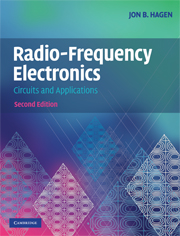Book contents
- Frontmatter
- Contents
- Preface
- 1 Introduction
- 2 Impedance matching
- 3 Linear power amplifiers
- 4 Basic filters
- 5 Frequency converters
- 6 Amplitude and frequency modulation
- 7 Radio receivers
- 8 Suppressed-carrier AM and quadrature AM (QAM)
- 9 Class-C, D, and E Power RF amplifiers
- 10 Transmission lines
- 11 Oscillators
- 12 Phase lock loops and synthesizers
- 13 Coupled-resonator bandpass filters
- 14 Transformers and baluns
- 15 Hybrid couplers
- 16 Waveguide circuits
- 17 Small-signal RF amplifiers
- 18 Demodulators and detectors
- 19 Television systems
- 20 Antennas and radio wave propagation
- 21 Radar
- 22 Digital modulation techniques
- 23 Modulation, noise, and information
- 24 Amplifier and oscillator noise analysis
- 25 The GPS Navigation system
- 26 Radio and radar astronomy
- 27 Radio spectrometry
- 28 S-parameter circuit analysis
- 29 Power supplies
- 30 RF test equipment
- Index
11 - Oscillators
Published online by Cambridge University Press: 05 June 2012
- Frontmatter
- Contents
- Preface
- 1 Introduction
- 2 Impedance matching
- 3 Linear power amplifiers
- 4 Basic filters
- 5 Frequency converters
- 6 Amplitude and frequency modulation
- 7 Radio receivers
- 8 Suppressed-carrier AM and quadrature AM (QAM)
- 9 Class-C, D, and E Power RF amplifiers
- 10 Transmission lines
- 11 Oscillators
- 12 Phase lock loops and synthesizers
- 13 Coupled-resonator bandpass filters
- 14 Transformers and baluns
- 15 Hybrid couplers
- 16 Waveguide circuits
- 17 Small-signal RF amplifiers
- 18 Demodulators and detectors
- 19 Television systems
- 20 Antennas and radio wave propagation
- 21 Radar
- 22 Digital modulation techniques
- 23 Modulation, noise, and information
- 24 Amplifier and oscillator noise analysis
- 25 The GPS Navigation system
- 26 Radio and radar astronomy
- 27 Radio spectrometry
- 28 S-parameter circuit analysis
- 29 Power supplies
- 30 RF test equipment
- Index
Summary
Oscillators are autonomous dc-to-ac converters. They are used as the frequency-determining elements of transmitters and receivers and as master clocks in computers, frequency synthesizers, wristwatches, etc. Their function is to divide time into regular intervals. The invention of mechanical oscillators (clocks) made it possible to divide time into intervals much smaller than the Earth's rotation period and much more regular than a human pulse rate. Electronic oscillators are analogs of mechanical clocks.
Negative feedback (relaxation) oscillators
The earliest clocks used a “verge and foliot” mechanism which resembled a torsional pendulum but was not a pendulum at all. These clocks operated as follows: torque derived from a weight or a wound spring was applied to a pivoted mass. The mass accelerated according to Torque = I d2θ/dt2 (the angular version of F = ma). When θ reached a threshold, θ0, the mechanism reversed the torque, causing the mass to accelerate in the opposite direction. When it reached −θ0 the torque reversed again, and so on. The period was a function of the moment of inertia of the mass, the magnitude of the torque, and the threshold setting. These clocks employed negative feedback; when the controlled variable had gone too far in either direction, the action was reversed. Most home heating systems are negative feedback oscillators; the temperature cycles between the turn on and turn off points of the thermostat. Negative feedback electronic oscillators are called “relaxation oscillators.”
Information
- Type
- Chapter
- Information
- Radio-Frequency ElectronicsCircuits and Applications, pp. 120 - 133Publisher: Cambridge University PressPrint publication year: 2009
